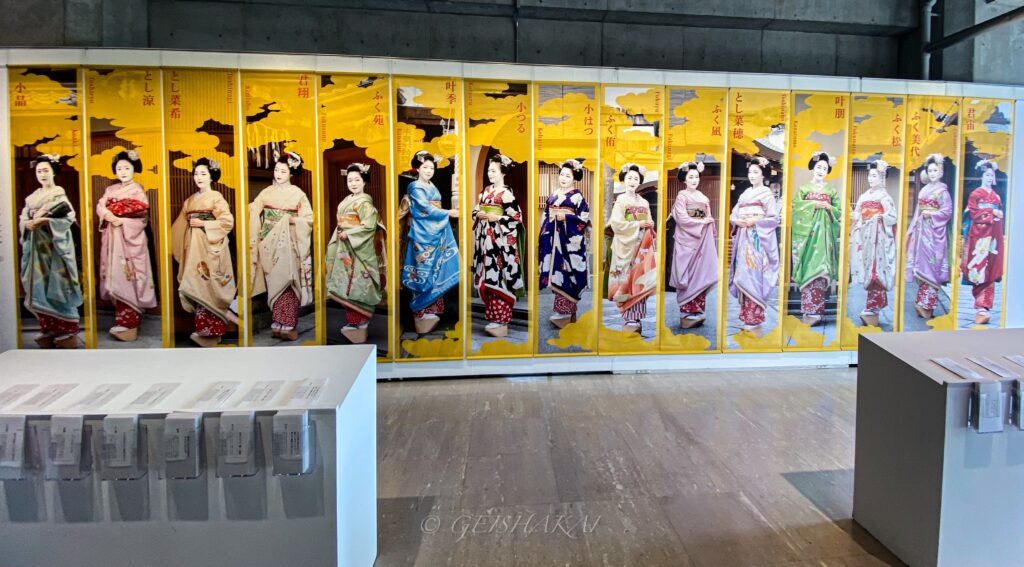
This year’s Kyo Odori was held at Shunjuza—a stage located within the campus of Kyoto University of Art and Design. An artsy college atmosphere was very welcoming and familiar, while the performance was excellent, easy to understand, and extremely entertaining.

Kyo Odori was held for only a week this year. Miyagawacho Kaburenjo was torn down last year, and as a new building is still being constructed, the geiko and maiko of Miyagawacho had to seek another venue. In the past, Shunjuza already proved its ability to host an odori for Gion Kobu. Yet, Miyagawacho’s familiar and casual atmosphere seems to be a perfect match for this university theater.

Miyagawacho strongly relies on its art in the recent years. The district’s council schools even the youngest maiko in musical instruments and the odori performances are always creative and spectacular, providing an unforgettable back story and context. Every year, Kyo Odori feels like a modern kabuki adaptation. Miyagawacho geiko are excellent actresses, highlighting Miyagawacho’s kabuki roots on stage. On a personal note, geiko Miehina could be a very successful takarazuka performer, as her (mostly male) roles are always breathtaking.




Even though Kyo Odori recycled some of the gag ideas from the previous (pandemic) years, it was a stunning and fantastic performance with a perfect culmination of the catchy finale song, Miyagawacho Ondo. After the spectacle, a small art exhibition was waiting for the audience to explore, along with the freshly debuted maiko leading the guests to the tea ceremony room. The young artists were portrayed on a photo wall in the main hall. Each maiko was interviewed, and pamphlets with their names were free to pick up from the gallery. Judging from the amount of distributed leaflets, it turned into some form of a popularity contest.
Translated pamphlets are available on my Patreon! Subscribe to unlock


As Shunjuza is a part of the Kyoto University of Design, traditional craftsmen held an honorable place at the theatre. After all, these artisans are who create the kagai. They are behind the success of each maiko and geiko. However, it is a high-risk profession that requires endless perfection.


Kyo Katsura Imanishi monopolizes creating and maintaining geiko’s wigs. Their customers include not only Kyoto geiko but also geigi and geisha from other smaller towns around Japan. This family business (established in 1966 and run by a father and son) is always present at every erikae in Kyoto’s five hanamachi. “Geiko wear their wigs daily for long hours; katsura is like an integral body part. I want to make them feel comfortable at work. It is also essential to look beautiful during the banquets, even when looking from a short distance. I have these two things in mind – beauty and comfort – when I make a custom katsura for each geiko”, says master Imanishi-san.


While geiko wear wigs, maiko style their natural hair into complicated nihongami. Such hairstyles are pretty demanding and challenging to maintain. Beautiful hair has been a top priority of Japanese women for centuries. Jyusanya is a shop producing wooden combs (kushi), an essential tool for keeping the nihongami hairstyles, since 1875. The current owner of Jyusanya, Takeuchi-san, is the fifth generation of kushi artisans. Wooden comb making is a dying art nowadays since nihongami is worn almost exclusively by maiko. It is rather impossible to find other Japanese women who tie their hair in nihongami daily. Since maiko’s population is small, the business is also humble. It takes about ten years of studying to create a kushi without assistance. The wooden “teeth” of the combs are quite sensitive and require a lot of attention from the wearer.


One of the most striking elements of a maiko’s costume is the high clogs, called okobo. Gion Choboya has provided wooden shoes for maiko and geiko since 1954. Sakurai-san is the third-generation owner of Choboya. The founder of Choboya studied at his relative’s geta shop in Kyoto for… 25 years before opening his own store. “Chobo” means “a dot/single stroke” in Japanese. When you write in kanji, you need to start every character with a small mark of ink. This is the philosophy of Choboya—shoes are as essential for people as the first kanji stroke’s intention is for writing. Sakurai-san crafts geta and okobo from wood, but he makes his zori shoes from other materials, such as cork, leather, or vinyl. The final step of producing this traditional footwear is attaching the straps, hanao. The technique of tying hanao decides the comfort of wearing geta or zori. This is why all shoes at Choboya are custom-made—the customers’ feet are measured, and the hanao fit comfortably.



Uchiwa are round-shaped summer fans made of bamboo and paper with geiko and maiko’s names written with red ink. Komaruya was founded in 1624 and continues making uchiwa through different Japanese eras. Uchiwa are distributed by maiko and geiko to their patrons and local businesses in summer as a form of seasonal greetings and gratitude. A female artisan of Komaruya, Sumii-san, says: “Geiko and maiko protect Kyoto’s traditional culture. It is crucial to pass the custom of uchiwa and be involved in this tradition”.
If you like this article, buy me a ramen or join me on Patreon! I don’t run any ads on my website so your support is the only way to keep it active ♡
京おどり Kyo Odori @ 春秋座 Shunjuza, Kyoto University of Art and Design (京都造形芸術大学)
1.04.2023 ~ 9.04.2023

Loved this!!💚💚💚